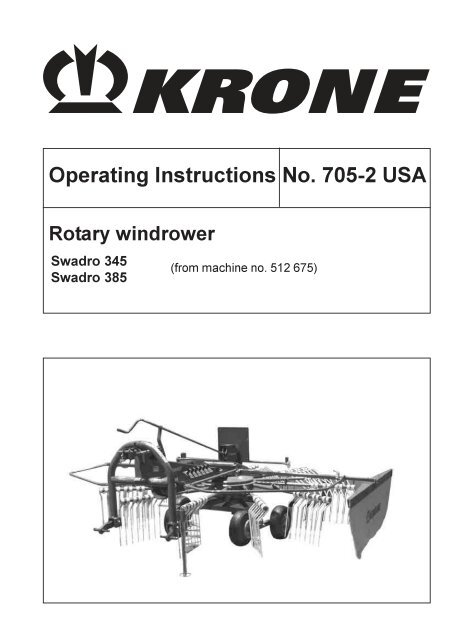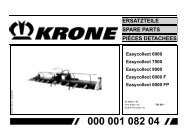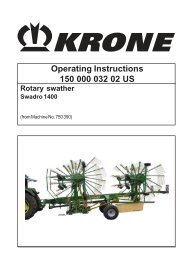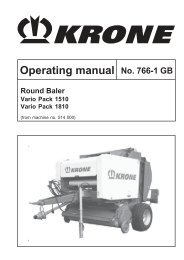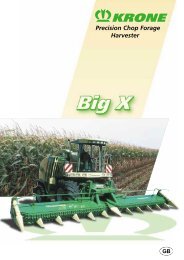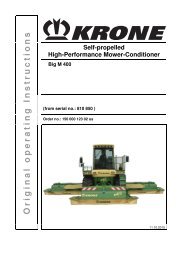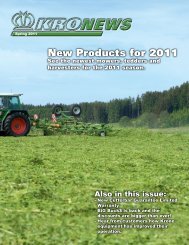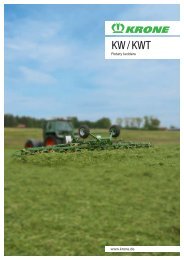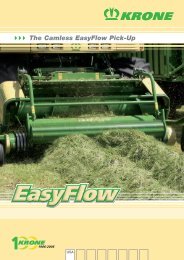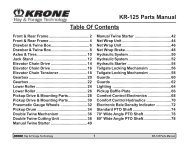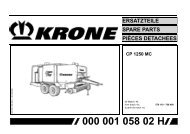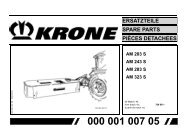Operating Instructions No. 705-2 USA
Operating Instructions No. 705-2 USA
Operating Instructions No. 705-2 USA
You also want an ePaper? Increase the reach of your titles
YUMPU automatically turns print PDFs into web optimized ePapers that Google loves.
<strong>Operating</strong> <strong>Instructions</strong> <strong>No</strong>. <strong>705</strong>-2 <strong>USA</strong><br />
Rotary windrower<br />
Swadro 345<br />
Swadro 385<br />
(from machine no. 512 675)
I. Foreword<br />
Dear customer,<br />
Ordering Replacement Parts<br />
We thank you for the trust you have placed in us by<br />
purchasing this machine.<br />
When you received this machine, the dealer should<br />
have given you instructions for the operation,<br />
maintenance and adjustment of the machine.<br />
However, this brief introduction to the machine can<br />
not replace a detailed acquaintance with the different<br />
tasks and functions of the machine and the proper way<br />
of treating it.<br />
These operating instructions are designed so that you<br />
are extensively informed of the activities required in<br />
each area, from commissioning and operation to the<br />
maintenance and care of the machine. The structure of<br />
the individual chapters in the text and illustrations<br />
corresponds to the sequence of work procedures when<br />
you use the machine.<br />
Read these operating instructions carefully before you<br />
use the machine, and pay special attention to the<br />
safety instructions.<br />
Important: To avoid accidents and to ensure<br />
maximum results, no alterations may<br />
be made to the machine without the<br />
manufacturer´s permission. Similarly,<br />
the machine must only be used under<br />
the conditions prescribed by Krone.<br />
This symbol is designed to draw attention<br />
to the safety instructions contained in the<br />
operating instructions. These instructions<br />
must be observed to prevent accidents.<br />
You will find this symbol at various points<br />
in the operating instructions. It indicates<br />
special handling information which must<br />
be particulary followed when the machine<br />
is used.<br />
Type<br />
Mach. <strong>No</strong>.<br />
Year<br />
Jahr<br />
Année<br />
Type<br />
Maschinenfabrik Bernard Krone GmbH<br />
Heinrich-Krone-Straße 10, D 48480 Spelle<br />
Masch. Nr<br />
<strong>No</strong>. de série<br />
When ordering replacement parts, the machine type,<br />
machine number and year of manufacture must be<br />
given. These details can be found on the identification<br />
label on the machine.<br />
We recommend that these details be entered in the<br />
above boxes so that they are readily available.<br />
And please remember that imitations and copies of<br />
parts, especially wearing parts, do not keep what they<br />
appear to promise. Material quality is difficult to test<br />
visually, therefore special care is required when<br />
purchasing cheap offers and imitation parts!<br />
The simplest remedy:<br />
Purchase only original KRONE parts!<br />
Made in<br />
W.-Germany<br />
All information, illustrations and technical information in<br />
the operating instructions represent the latest status at<br />
the date of publication. The company reserves the right<br />
to make constructional alterations at any time and<br />
without prior notice or obligation.<br />
3
List of contents<br />
1. Introduction .......................................................................................... 8<br />
1.1 Positioning of the safety labels on the machine, containing technical safety information 8<br />
1.2 Positioning of the general safety labels on the machine ............................................. 10<br />
2. Preparing for use ................................................................................ 12<br />
2.1. Special safety notes .................................................................................................. 12<br />
2.2 Connection to the tractor ........................................................................................... 12<br />
2.3 PTO shaft .................................................................................................................. 13<br />
2.3.1 General information ................................................................................................... 13<br />
2.3.2 Length adjustment of the PTO shaft ........................................................................... 14<br />
2.3.3 Installation and servicing of the PTO shaft. ................................................................. 14<br />
2.4 Disconnection from the tractor ................................................................................... 15<br />
3. Adjusting the swather ........................................................................ 16<br />
3.1 Basic setting ............................................................................................................. 16<br />
3.2 Installing and removing the tine bars .......................................................................... 16<br />
3.3 Schutzbügel umklappen............................................................................................. 17<br />
3.4 Swath former ............................................................................................................. 17<br />
3.5 Adjusting the working depth ....................................................................................... 17<br />
3.6 Side angle adjustment of the chassis with tandem tyres ............................................. 18<br />
3.7 Adjusting the cam track ............................................................................................. 18<br />
4. Road travel regulations ..................................................................... 19<br />
4.1 Transport on public roads .......................................................................................... 19<br />
4.2 Preparation for transport ........................................................................................... 19<br />
4.3 Nachlaufverriegelung ................................................................................................. 19<br />
5. Care and maintenance....................................................................... 20<br />
5.1. Special safety notes .................................................................................................. 20<br />
5.2 General ..................................................................................................................... 20<br />
5.3 Tyres ......................................................................................................................... 21<br />
5.4 Lubrification .............................................................................................................. 22<br />
6. Winter storage..................................................................................... 23<br />
7. Starting-up after winter storage........................................................ 23<br />
8. Extras/accessories ............................................................................ 24<br />
8.1 Support wheel with chain-type top link........................................................................ 24<br />
9. Technical Data..................................................................................... 25<br />
Supplement to the operator's manual ........................................................... 26<br />
Assembly instructions (first assembly) ........................................................................................ 26<br />
1. Preparatory work................................................................................ 26<br />
4
III. General<br />
Operation in accordance with specifications<br />
The Rotary Windrower is built solely for normal agricultural<br />
use (operation in accordance with specifications).<br />
Use of the machine for any other purpose is considered as<br />
an operation which is not in accordance with specifications<br />
and is undertaken as such at the owner’s risk.<br />
Observation of the operation and maintenance instructions<br />
specified by the manufacturer shall also be taken to<br />
be a part of operation in accordance with specifications.<br />
The Rotary Windrower may only be operated, serviced<br />
and repaired by personnel who are familiar with these<br />
functions and who have been instructed of the inherent<br />
dangers.<br />
All relevant accident prevention, safety, health and highway<br />
regulations must be complied with.<br />
Never carry out changes yourself. Otherwise no warranty<br />
will be assumed for resulting damage.<br />
Rule:<br />
Before every operation check both<br />
implement and tractor for working and<br />
road safety.<br />
General safety and accident prevention regulations<br />
1. In addition to the instructions given in this manual all<br />
relevant safety and accident prevention regulations<br />
must be complied with.<br />
2. Pay special attention to the warning advice and safety<br />
decals which will instruct you of the safe operation of<br />
your implement. Observe them in your own interest.<br />
3. Take account of the Road Traffic Regulations in force<br />
in your country when travelling on public roads.<br />
4. Before starting work you should make yourself familiar<br />
with all elements and controls of the machine, as well<br />
as with their function. This will be too late during work.<br />
5. The user of the machine should only wear well-fitting<br />
clothes.<br />
6. Keep the machine clean at all times (fire precaution).<br />
7. Before starting the tractor make sure that nobody,<br />
particularly children, are in the danger area. Good<br />
visibility is essential.<br />
8. <strong>No</strong> persons are allowed on the implement, either<br />
during work or during road travel.<br />
9. Attach the implement to the tractor according to the<br />
instructions given in this manual, using exclusively the<br />
devices provided for this purpose.<br />
10.When mounting or removing the implement set the<br />
parking stand to the position which assures sufficient<br />
stability.<br />
11.Proceed with special care when mounting and removing<br />
the implement on/from the tractor.<br />
12.Ballast weights for the tractor are to be applied<br />
exclusively to the points provided for this purpose.<br />
13.Take notice of the permissible axle load, total weight<br />
and transport dimensions.<br />
14.Check and install all equipment required for transportation<br />
such as lighting, warning and protective devices.<br />
15.All operating devices such as ropes, chains, rods etc.<br />
which act on remote-controlled machine elements,<br />
have to be installed in such a way that unintentional<br />
movements are excluded in all transport and working<br />
positions.<br />
16.Before any transport on public roads set the implement<br />
to the position prescribed and lock it in accordance with<br />
the instructions given by the manufacturer.<br />
17.During travel never leave the driving position.<br />
18.Always select the speed according to the travel<br />
conditions. When travelling up-hill, down-hill or across<br />
a slope avoid sudden turns.<br />
19.The behaviour of the tractor when travelling, can be<br />
influenced by mounted or trailed implements and ballast<br />
weights. It is therefore essential that a sufficient steering<br />
and braking system is available at all times.<br />
20.When negotiating curves take notice of the overhang<br />
and/or flywheel mass of the implement.<br />
21.Before operating the implement make sure all protective<br />
devices are installed and in position.<br />
22.Keep clear of the working area of the implement.<br />
5
23.Keep clear of the swinging area of the implement.<br />
24.Hydraulically controlled hinged frames may only be<br />
operated if nobody is standing in the danger area.<br />
25.Caution when working on machine elements operated<br />
by additional driving systems (e.g. hydraulics). Shearing<br />
and pinching areas!<br />
26.Before leaving the tractor lower the implement to the<br />
ground, stop the engine and remove the ignition key.<br />
27.<strong>No</strong>body is allowed to stand between tractor and implement<br />
as long as the vehicle is not secured against<br />
unintentional movement by means of the parking brake<br />
and/or chocks.<br />
Mounted implements<br />
1. Before mounting implements on/from the three-point<br />
linkage, all controls have to be positioned in such a way<br />
that any unintentional lifting or lowering of the machine<br />
is impossible.<br />
2. In case of three-point mounted implements it is essential<br />
that the hitch category of the implement matches<br />
that of the tractor.<br />
3. The three-point linkage includes shearing and pinching<br />
areas.<br />
4. When operating the outer controls of the three-point<br />
linkage do not step between tractor and implement.<br />
5. When the implement is in transport position assure at<br />
all times a sufficient lateral limitation of the tractor<br />
three-point linkage.<br />
6. When travelling on public roads with implement raised<br />
make sure the control lever is secured against lowering.<br />
4. Before installing or removing the p.t.o. shaft, disengage<br />
the p.t.o., stop the engine and remove the ignition<br />
key.<br />
5. Should overload or overrunning clutches not be covered<br />
by the tractor guards, the p.t.o. shaft has to be installed<br />
with the safety clutch at the implement side.<br />
6. Make sure at all times that the p.t.o. shaft is properly<br />
installed and secured.<br />
7. Hook in the chain to secure the p.t.o. shaft guard against<br />
rotation.<br />
8. Before engaging the p.t.o. make sure the selected<br />
tractor p.t.o. speed is in accordance with the permissible<br />
speed of the implement.<br />
9. When using a ground speed p.t.o. take into account that<br />
the p.t.o. speed depends on the travel speed and the<br />
direction of rotation is reversed by backward movements.<br />
10.Before engaging the p.t.o. be sure that nobody is<br />
standing in the danger area of the implement.<br />
11. Never engage the p.t.o. while the engine is stopped.<br />
12.Keep all persons clear of the p.t.o. and p.t.o. shaft while<br />
the driving system is in operation.<br />
13.Always disengage the p.t.o. for very sharp turns or<br />
when p.t.o. operation is not required.<br />
14.Danger! Working elements continue to rotate after the<br />
p.t.o. is disengaged. Keep clear of rotating parts at all<br />
times. Be sure the implement has stopped rotating<br />
before carrying out any work.<br />
15.Before cleaning, lubricating or adjusting the implement<br />
or the p.t.o. shaft, disengage the p.t.o., stop the engine<br />
and remove the ignition key.<br />
16.Place the detached p.t.o. shaft onto its support.<br />
Power take-off operation<br />
1. Do not use other p.t.o. shafts than those specified by<br />
the manufacturer.<br />
17.After the p.t.o. shaft is detached place the protective<br />
covering over the p.t.o. stub.<br />
18.Damages have to be repaired at once before the<br />
implement is set into operation.<br />
2. The guard tube and the funnel-shaped guard of the<br />
p.t.o. shaft as well as the p.t.o. guard must be installed.<br />
All guards must be in perfect working<br />
condition.<br />
3. Take notice of the overlap prescribed for p.t.o. shaft<br />
tubes, both in transport and working positions.<br />
6
Hydraulics<br />
1. Caution! The hydraulic system is pressurized.<br />
2. When connecting hydraulic rams and motors be<br />
sure the hydraulic hoses are coupled as prescribed.<br />
3. When coupling hydraulic hoses to the tractor hydraulics<br />
the hydraulic system must not be under<br />
pressure, either at the tractor or at the implement<br />
side.<br />
4. In the case of hydraulic connections between tractor<br />
and implement it is advisable to mark the coupling<br />
sleeves and plugs to ensure correct fitting.<br />
5. Check the hydraulic hoses at regular intervals and<br />
renew them when damaged or worn. The new hoses<br />
must comply with the technical requirements laid<br />
down by the manufacturer of the implement.<br />
6. When tracing leakages use appropriate protective<br />
devices. Danger of injury!<br />
7. Hydraulic oil forced out under high pressure can<br />
break the skin and cause severe damage to health.<br />
In case of injury by hydraulic oil report immediately<br />
to a doctor as there is a grave risk of infection.<br />
8. Before working on the hydraulics lower the implement,<br />
release pressure from the system and stop<br />
the tractor engine.<br />
Tyres<br />
1. Prior to working on the tyres make sure the machine<br />
is standing safely and secured against unintentional<br />
movements (wheel chocks!).<br />
Maintenance<br />
1. As a rule, disengage the driving system and stop the<br />
engine before carrying out any maintenance,<br />
servicing or cleaning work and before remedying<br />
operational disorders. Always remove the ignition<br />
key.<br />
2. Check all bolts and nuts at regular intervals and<br />
retighten as required.<br />
3. Prop the implement with appropriate supports before<br />
carrying out any maintenance work under the lifted<br />
machine.<br />
4. When changing working elements with cutting edges<br />
use appropriate tools and protective gloves.<br />
5. Discard used oil, fuel and filters according to regulations.<br />
6. When working on the electric system always cut out<br />
the current supply.<br />
7. All protective devices subject to wear must be<br />
checked regularly and renewed if worn or damaged.<br />
8. Before carrying out electric welding on the tractor or<br />
mounted implement detach the cable from both<br />
alternator and battery.<br />
9. Spare parts must comply with the technical requirements<br />
specified by the manufacturer. This is<br />
assured by the use of genuine spare parts.<br />
10.When filling up gas accumulators use nitrogen only.<br />
Danger of explosion!<br />
2. The installation of tyres presupposes special knowledge<br />
as well as the availability of all necessary<br />
tools.<br />
3. Repair work on tyres and wheels may only be<br />
carried out by skilled workers who use the appropriate<br />
tools.<br />
4. Check the inflation pressure at regular intervals.<br />
Take notice of the inflation pressure laid down.<br />
7
1. Introduction<br />
The KRONE rotary swather is equipped with all the necessary safety devices (protective equipment). <strong>No</strong>t all danger<br />
spots on this machine can be made totally safe considering that it also necessary to keep the machine functional.<br />
There are corresponding danger notices on the machine indicating these remaining danger spots.<br />
These safety notices are in the form of warning signs. You will find important information on the positioning of these<br />
danger signs, their meanings and denotations in the following notes.<br />
Familiarise yourself with the meaning of the warning signs. The text beside them and their<br />
location on the machine indicates the machine's particularly dangerous areas.<br />
1.1 Positioning of the safety labels on the machine, containing technical<br />
safety information<br />
6<br />
1 3<br />
6<br />
2<br />
5<br />
4<br />
KS200030<br />
8
939 100-4<br />
1 2<br />
MAX. 540/min<br />
MAX. 200 bar<br />
Before starting up, read the operating manual<br />
and safety instructions and follow them.<br />
Order no. 939 100-4 (1x)<br />
The PTO shaft speed<br />
must not exceed<br />
540 rpm!<br />
Order no. 942 019-1 (1x)<br />
Order no. 939 462-0 (1x)<br />
3 4<br />
Before starting work put the<br />
guard bar into the protective<br />
position (fold down).<br />
Danger in the operating range of<br />
the swather disc - Keep clear!<br />
Order no. 939 574-0 (1x)<br />
939 574-0<br />
Order no. 939 472-2 (2x)<br />
5<br />
6<br />
Never put your hand into<br />
the danger area as long<br />
as parts may be moving.<br />
Order no. 942 196-1 (2x)<br />
Order no. 949 228-0 (1x)<br />
Order no. 949 229-0 (1x)<br />
9
1.2 Positioning of the general safety labels on the machine<br />
1<br />
3<br />
2<br />
4<br />
KS200031<br />
1 942 021-5 (2x) Swadro 345<br />
2 942 118-0 (1x)<br />
3<br />
942 022-5 (2x) Swadro 385<br />
942 298-0 (1x)<br />
1,5 bar<br />
24<br />
4<br />
942 107-1 (2x) 939 212-1<br />
939 212-1<br />
10
2. Preparing for use<br />
2.1. Special safety notes<br />
• Always turn off the power take off before carrying out servicing, maintenance, repair or<br />
assembly work on the rotary swather. Switch off the engine and remove the ignition key.<br />
Secure the tractor and rotary swather from rolling away.<br />
• Maximum drive speed is 540 r.p.m.<br />
• Actuating components such as ropes, pulling ropes, hydraulic hoses and cables should<br />
be laid in such a way that they cannot be activated unintentionally or come into contact<br />
with the tractor wheels. Accident risk!<br />
• <strong>No</strong>body should be between the tractor and rotary swather during raising or lowering<br />
operations. Extreme risk of injury!<br />
• Before switching on the PTO shaft, ensure that nobody is in the rotary swather danger area.<br />
Accident risk!<br />
• Check that the protective devices are correctly fitted in accordance with guidelines during<br />
operation and when using public highways. Attach the lights and check that they function<br />
properly.<br />
• <strong>Operating</strong> personnel must not leave the tractor when operation is in progress.<br />
Put the operation device into position before attaching/<br />
detaching units to/from the three point linkage in order to<br />
stop unintentional raising or lowering.<br />
Special care should be taken when coupling/uncoupling<br />
implements to/from the tractor.<br />
Risk of injury in the three point linkage zone by crushing<br />
or shearing.<br />
The swather is equipped with category I and II coupling<br />
lugs for the three point hydraulics.<br />
2.2 Connection to the tractor<br />
The swather is equipped with category I and II coupling<br />
lugs for the three point hydraulics.<br />
• Ensure that nobody is between the<br />
machinery and the tractor when<br />
connecting the rotary swather.<br />
• Ensure that the tractor has sufficient<br />
steering capability when the rotary<br />
swather is in the raised position.<br />
Increase the front axle load if<br />
necessary.<br />
– Install and secure the lower link arm.<br />
– Attach the top link arm and secure with bolts.<br />
– Raise the parking leg and secure it in the uppermost<br />
position with a pin. Do not remove the parking leg.<br />
The rear hydraulic lowering speed must<br />
be set (by adjusting the lowering throttle)<br />
so that the rotary swather chassis is<br />
slowly placed on the ground.<br />
KS200047<br />
12
2.3 PTO shaft<br />
2.3.1 General information<br />
Turn the engine off after coupling the<br />
rotary swather to the upper and lower<br />
link arms. Remove the ignition key.<br />
Secure the tractor from rolling away.<br />
The PTO shaft is equipped with an overload<br />
coupling. Overload couplings protect the tractor<br />
and machinery against damage. The overload<br />
coupling setting should not be altered. The<br />
guarantee will cease to be valid if the overload<br />
coupling torque is altered by tampering.<br />
The torque is limited at overload and transferred in<br />
pulses during slippage time.<br />
Immediately turn off the PTO shaft if the<br />
overload coupling is activated in order to<br />
avoid premature wear of the overload<br />
coupling.<br />
KS-385-5<br />
Compare the torque value RM stamped on<br />
the location shown in the illustration with the<br />
values given in the following table. Contact<br />
your Krone dealer if the values do not match.<br />
Type<br />
Swadro 345<br />
Swardro 385<br />
Torque (RM)<br />
550 Nm<br />
550 Nm<br />
13
2.3.2 Length adjustment of the PTO shaft<br />
• Always switch off the power take off before carrying out servicing, maintenance, repair or<br />
assembly work on the rotary swather. Switch off the engine. Remove the ignition key.<br />
Secure the tractor and rotary swather from rolling away.<br />
• <strong>No</strong>body should be between the tractor and the rotary swather during raising or lowering<br />
operations.<br />
Risk of material damage: Do not raise the<br />
implement before the length of the PTO<br />
shaft has been adjusted.<br />
The PTO shaft is taken apart for length adjustment.<br />
Slide the corresponding PTO shaft halves into place on<br />
the machinery and tractor. The overload coupling<br />
must be attached to the implement. Connect the<br />
rotary swather to the rear hydraulics in the shortest<br />
position for the PTO shaft. Hold both halves next to<br />
each other and measure the correct length. Please refer<br />
to the PTO shaft manufacturer's operating manual for<br />
exact measuring and shortening procedures.<br />
1<br />
2<br />
KS200033<br />
2.3.3 Installation and servicing of the PTO shaft.<br />
Secure the protecting tubes (3) from rotating, with the<br />
retaining chain (4).<br />
Check the PTO shaft slewing range and free movement<br />
space. Damage can be caused by the tractor or<br />
implement coming into contact with the PTO shaft<br />
(e. g. trailed appliance, three-point frame).<br />
4<br />
3<br />
3<br />
4<br />
KS200035<br />
Lubricate PTO shafts with a multi-purpose grease at the<br />
distances shown in the diagram. Observe the PTO shaft<br />
manufacturer's operating instructions.<br />
8h<br />
20h<br />
8h<br />
Use a vegetable based lubricant for this purpose.<br />
40h<br />
40h<br />
8h<br />
AM-4-098<br />
14
2.4 Disconnection from the tractor<br />
• Make certain that the ground is firm and even, when turning off the rotary swather.<br />
• <strong>No</strong>body should be between the tractor and the rotary swather during raising or lowering<br />
operations.<br />
• Observe all other safety instructions.<br />
– Select a level, dry and sufficiently firm surface.<br />
– Lower stand (1) and secure with pin.<br />
– Completely lower the rotary swather and ensure that<br />
it is stable.<br />
– Disconnect PTO shaft (2) and place it on it's support.<br />
– Disengage and disconnect the top arm link.<br />
– Disconnect the lower arm link.<br />
2<br />
1<br />
KS200036<br />
15
3. Adjusting the swather<br />
• Only carry out repairs, maintenance/ cleaning work and troubleshooting when the drive is<br />
switched off and the engine is at a standstill. – Remove the ignition key.<br />
• The swather is designed for a PTO speed of max. 540 r.p.m.<br />
• Recommended PTO shaft operating speed 350 - 450 r.p.m.<br />
• The rotary swather should not be driven with a PTO speed of 1000 r.p.m. under ANY<br />
circumstances.<br />
3.1 Basic setting<br />
Slowly lower the swather. Set the tractor lower link arm<br />
to “lower” so that the bearing bolt (1) lays on the three<br />
point frame guide. Set the tractor top link arm so that the<br />
swather is horizontal to slightly angled forward and so<br />
that the tines are slightly touching the ground.<br />
1<br />
2<br />
KS200050<br />
3.2 Installing and removing the tine bars<br />
Before installing and removing the tine<br />
bars, be it for operation or transport, it<br />
must be ensured that any unintentional<br />
operation of pull rope (1) for unlocking<br />
the safety frames is excluded. Danger of<br />
accident!<br />
Installation<br />
• Withdraw the linch pins (1) from the tine bars.<br />
• Remove the tine bars (2) from transport rack (3) and<br />
slide them over the coupling arms of the rotor.<br />
• Lock the tine bars (2) using the linch pins (1).<br />
3<br />
2<br />
1<br />
KS200038<br />
2<br />
Removal<br />
• Withdraw the linch pins (1).<br />
• Remove the tine bars (2) from the coupling arms and<br />
lock them in their transport rack (3) located on the<br />
carrier frame. Make sure that the tines face the<br />
inside.<br />
• Lock the tine bars (2) using the linch pins (1).<br />
1<br />
KS200039<br />
16
3.3 Schutzbügel umklappen<br />
• Äußere Schutzbügel (1) links und rechts an der<br />
Maschine durch ziehen am Bolzen (2) nach außen in<br />
Arbeitsstellung schwenken.<br />
• Darauf achten, dass der Bolzen den Schutzbügel<br />
sichert.<br />
1<br />
2<br />
KS200048<br />
3.4 Swath former<br />
The distance between the swath former and the swather<br />
disk is infinitely adjustable for narrow or wide swath<br />
formation.<br />
Loosen the adjusting screw (7), move the swath<br />
former (8) into the desired position, retighten adjusting<br />
screw (7).<br />
The distance between the swath former and the<br />
swather disk is adjusted to the feed quantity.<br />
A lot of feed = larger distance<br />
<strong>No</strong>t much feed = smaller distance<br />
The travelling speed should be selected based on the<br />
appearance of the swath = (clean tine work with good<br />
swath formation).<br />
7<br />
8<br />
KS200032<br />
3.5 Adjusting the working depth<br />
The exact swather disk height is adjusted with the<br />
crank (1). Working depth setting depends on travelling<br />
speed and crop conditions.<br />
The feed is not completely gathered if the setting is too<br />
high, and if it is set too low can lead to soiling of the<br />
feed, damage of green sward and to increased wear of<br />
the twin spring tines.<br />
1<br />
KS200040<br />
17
3.6 Side angle adjustment of the<br />
chassis with tandem tyres<br />
Additional lateral inclination adjustment of the swather<br />
can be carried out by loosening the screws (1) on the left<br />
tandem arm, so that the tines are always guaranteed to<br />
follow the contours of the land.<br />
1<br />
KS200045<br />
3.7 Adjusting the cam track<br />
Loosen screws (1), unscrew screw (2), pull the adjusting<br />
lever (3) forwards to the direction of travel, raise the tine<br />
bars later (e.g. swath rotation), Push the adjusting lever<br />
(3) to the back in the direction of travel, raise the tine<br />
bars earlier (large swaths), reinsert screw (2) into an<br />
available thread bore and refasten screws (1).<br />
3<br />
1 2<br />
KS200046<br />
18
4. Road travel regulations<br />
4.1 Transport on public roads<br />
Ensure that the applicable guidelines on<br />
clearance lamps and safety precautions are<br />
adhered to with road transportation day or<br />
night. A lighting attachment set is available<br />
from your KRONE dealer. Standard sockets<br />
are available on the implement.<br />
4.2 Preparation for transport<br />
• Completely push the swath former in and secure the<br />
adjusting screw.<br />
• Fold up the protecting frame and let it engage.<br />
• Remove the tine bars and lock them in their transport<br />
rack (see section 3.2 “Installing and removing the tine<br />
bars”).<br />
KS200041<br />
4.3 Nachlaufverriegelung<br />
1<br />
Um ein Auschwenken des Schwaders<br />
in Transportstellung zu verhindern,<br />
muss der Dreipunktbock durch den<br />
Bolzen (1) arretiert werden.<br />
KS200049<br />
19
5. Care and maintenance<br />
5.1. Special safety notes<br />
• Before correcting any operational faults or carrying out any repair, maintenace or cleaning<br />
work, always disengage the driving system, stop the engine and remove the key from the<br />
ignition!<br />
• Avoid oil and grease coming into contact with the skin.<br />
• Contact a doctor immediately for injuries caused by escaping oil.<br />
• Follow all other safety notes to avoid injuries and accidents.<br />
5.2 General<br />
Certain maintenance and service interavals should be observed to guarantee correct<br />
operation of the rotary swather and to reduce wear and tear. These include, amongst other<br />
things, cleaning, greasing, lubricating and oiling parts and components.<br />
Torque moments M (unless otherwise stated)<br />
A = thread size<br />
(solidity class given on the head of the screw)<br />
A<br />
Ø<br />
5.6 6.8 8.8 10.9 12.9<br />
M A<br />
(Nm)<br />
M 4 2,2 3,0 4,4 5,1<br />
M 5 4,5 5,9 8,7 10<br />
M 6 7,6 10 15 18<br />
M 8 18 25 36 43<br />
M 10 29 37 49 72 84<br />
A<br />
8<br />
. 8<br />
1<br />
0<br />
9<br />
.<br />
M12 42 64 85 125 145<br />
M14 100 135 200 235<br />
M14x1,5 145 215 255<br />
KR-1-130<br />
M 16 160 210 310 365<br />
M16x1,5 225 330 390<br />
M 20 425 610 710<br />
M 24 730 1050 1220<br />
M 24x1,5 350<br />
M 24x2 800 1150 1350<br />
M 27 1100 1550 1800<br />
M 27x1,5 850<br />
M 27x2 1150 1650 1950<br />
M30 1450 2100 2450<br />
Periodically check all bolts and nuts and retighten if necessary!<br />
20
5.3 Tyres<br />
• Installation of tyres and wheels requires special knowledge and proper installation tools!<br />
• Repair work on the tyres may only be carried out by experts using suitable assembly tools.<br />
• Park the rotary swather on solid and level ground. Secure against rolling away<br />
unintentionally using wheel checks.<br />
• Check the air pressure regularly.<br />
Check the tyre pressure at regular intervals and top up<br />
Type<br />
Tyre size Tyre press<br />
air if necessary. The values can be taken from the<br />
[in bar]<br />
adjacent table. Swadro 345 16 x 6.50-8 1,5<br />
Swadro 385 16 x 6.50-8 1,5<br />
Front support wheel 16 x 6.50-8<br />
21
5.4 Lubrification<br />
All greasing points of your windrower are shown on this<br />
page. Observation of the maintenance and greasing<br />
intervals laid down will prolong the service life of the<br />
implement.<br />
As a rule, disengage the drive mechanism<br />
and stop the tractor before carrying out<br />
any maintenance, servicing or cleaning<br />
work and before remedying operational<br />
disorders. Always remove the ignition<br />
key from the tractor.<br />
Use oils and greases produced on<br />
vegetable basis.<br />
20h<br />
20h<br />
20h<br />
KS200042<br />
20h<br />
KS200043<br />
The cam track can be lubricated through the lubrication<br />
nipple (1) located in the lower part of the rotor. Apply the<br />
grease to the area between guide roller and cam track<br />
and turn the rotor several times to allow the grease to be<br />
distributed over the entire cam track.<br />
20h<br />
KS200044<br />
22
6. Winter storage<br />
1. Store the machine in a weather-proof building.<br />
Never store the machine next to artificial fertilizers.<br />
2. Thoroughly clean the machine. Dirt involves the<br />
formation of moisture which entails rusting. If<br />
cleaning with a high-pressure washing device do<br />
not direct the water jet at the bearings.<br />
3. Make sure all movable parts such as tension<br />
pulleys, hinges etc. move freely. If necessary<br />
movable parts have to be removed, cleaned,<br />
checked for wear and replaced by new ones as<br />
required.<br />
4. Lubricate all hinge points.<br />
5. Lubricate the machine thoroughly.<br />
6. Grease the PTO shaft guard tubes to prevent them<br />
freezing.<br />
7. Touch up damaged paintwork, spray damaged<br />
areas with anti-rust fluid.<br />
8. Clean chains with diesel fuel, let dry and lubricate<br />
with viscous oil.<br />
7. Starting-up after winter<br />
storage<br />
1. Remove oil and grease which was applied for the<br />
preservation of chains and the machine.<br />
2. Grease the machine completely to allow any<br />
accumulation of condensed water in the bearings<br />
to be eliminated.<br />
3. Check the inflation pressure in the tyres.<br />
4. Check the oil level in the gearbox an top up as laid<br />
down by the manufacturer.<br />
5. Retighten all bolts and nuts.<br />
6. Be sure all machine components are correctly<br />
adjusted and readjust as required.<br />
7. Spin the slip clutch to free the linings.<br />
9. Read thoroughly the instruction manual again.<br />
Important:<br />
Use oils and greases produced on<br />
vegetable basis.<br />
9. Jack up the machine to relieve load on tyres, do<br />
not deflate tyres, protect tyres against sun, grease<br />
and oil.<br />
10. Take a note of all spare parts required and order<br />
them in time. It will be easier for your KRONE<br />
Dealer to supply and install spare parts before the<br />
start of the season. What is more, your machine<br />
will be ready for use before the start of the next<br />
season. What is more, your machine will be ready<br />
for use before the start of the next season.<br />
23
8. Extras/accessories<br />
8.1 Support wheel with chain-type<br />
top link<br />
On Swadro the support wheel with chain-type top link<br />
has to be fitted to the right hand side of the headstock<br />
when seen in the travel direction.<br />
Support wheel installation :<br />
Fit support wheel bracket (1) to the headstock tube<br />
using clamps (2). When doing this swing bracket (1)<br />
abt. 45° towards the machine centre until the oscillating<br />
range of wheel (3) is identical on both sides for the<br />
negotiation of curves. Attach chain support (4) to the<br />
top link using the top link pin. Install tension spring (5).<br />
5<br />
4<br />
1<br />
3<br />
Adjusting the working depth :<br />
Remove linch pin (6), move wheel (3) to the desired<br />
position and secrue again using linch pin (6).<br />
Attach chain (4) to the top linkage point of the swather<br />
so that it is slightly slagging with the machine lowered.<br />
This will allow the swather to follow the ground contours<br />
accurately.<br />
2<br />
For road transport always use the fixed<br />
top link!<br />
6<br />
24
9. Technical Data<br />
Type<br />
Swadro 345<br />
Swadro 385<br />
Three point linkage standard standard<br />
Single axle Special accessory Special accessory<br />
Parallel axle Special accessory Special accessory<br />
Tandem axle standard standard<br />
Number of arms 10 12<br />
Number of double tines per arm 3 4<br />
Working width mm 3400 3800<br />
Swath rotor diameter mm 2870 3200<br />
Height mm 2500 2650<br />
Height in operating position mm 1420 1420<br />
Length mm 3250 3690<br />
Width in transport position mm 1640 1640<br />
Width in operating positon mm 3400 3800<br />
Power requipment approx. kW/HP 29/40 29/40<br />
PTO shaft speed max. permitted drive speed 540 t/min 540 t/min<br />
recommended operating drive speed 350–450 t/min 350–450 t/min<br />
Equivalent continous sound pressure lev. below 70 db (A) below 70 db (A)<br />
Acreage capacity approx. per hour 4,5 5<br />
Tyres 16 x 6.50-8 16 x 6.50-8<br />
Tyres pressure bar 1,5 1,5<br />
25
Supplement to the operator's manual<br />
Assembly instructions (first assembly)<br />
1. Preparatory work<br />
The following instructions give a description of the first assembly of the KRONE rotary rakes<br />
Swadro 345 and Swadro 385.<br />
The assembly of the rotary rakes must only be carried out by an authorized specialist<br />
workshop.<br />
The following assembly steps have to be carried out in the prescribed sequence.<br />
Special care is essential when carrying out the assembly work. Observe all accident<br />
prevention regulations. Only use safe and adequately dimensioned lifting and securing<br />
devices. The rotary rake must only be operated when all guard are fitted. Any arbitrary<br />
modification to the machine will relieve the manufacturer of all liability for any resulting<br />
damage.<br />
First remove the PVC sheet and the cover of the transport box. Take out of the box all components except the rotor<br />
and the carrier arm. Remove the side walls of the transport box.<br />
26
• Muttern (1) von den vier Radachsen demontieren.<br />
1<br />
KS200001<br />
• Use a solvent to remove the rust preventing agent from<br />
all four wheel axles.<br />
Observe the safety instructions of the<br />
solvent manufacturer.<br />
1<br />
• Slightly lubricate the axles using lubricating grease.<br />
KS200002<br />
• Install the wheels.<br />
• Die vier Räder mit Muttern (1) und Scheiben befestigen.<br />
1<br />
KS200003<br />
• Beat the bearing portecting cap (1) into position.<br />
1<br />
KS200004<br />
27
• Remove bolts (1) from the undercarriage.<br />
1<br />
KS200000<br />
• Strebe (1) in Fahrwerk mit Bolzen (4) montieren und<br />
mit Scheibe (2) und Splint (3) sichern.<br />
1<br />
Fahrwerk gegen Wegrollen sichern.<br />
2<br />
3<br />
4<br />
KS200005<br />
• Bolzen (4) aus dem Kreisel demontieren<br />
• Den Kreisel (1) mittels Hebevorrichtung auf das<br />
vorbereitete und gesicherte Fahrgestell (3) heben.<br />
• Dabei die Strebe (2) , wie im Bild gezeigt, durch den<br />
Kreisel (1) führen.<br />
• Kreisel abstützen<br />
4<br />
2<br />
1<br />
3<br />
KS200006<br />
• Den Kreisel (1) herablassen, mit Bolzen (2) und<br />
Scheiben montieren. Anschließend mit Splint (3)<br />
sichern.<br />
2<br />
1<br />
3<br />
KS200008<br />
28
• Den Tragholm (1) mittels Hebevorrichtung an das<br />
Getriebe (2) montieren.<br />
• Die Antriebswelle im Tragholm (1) mit der Getriebeeingangswelle<br />
(3) montieren. Durch leichtes Drehen,<br />
an der Antriebswelle vorne, wird die Montage erleichtert.<br />
• Die 4 Schrauben (4) M16 x 35 und Sperrkantscheiben<br />
über Kreuz anziehen.<br />
Anzugsmoment: min. 210 NM<br />
• Tragholm vorne abstützen<br />
2<br />
3<br />
1<br />
4<br />
4<br />
KS200009<br />
• Aus dem Dreipunktbock den Bolzen (1) demontieren.<br />
1<br />
KS200010<br />
• Dreipunktbock (1) mittels Hebevorrichtung an den<br />
Tragholm montieren.<br />
1<br />
KS200011<br />
29
• Dreipunktbock am Tragholm mittels Bolzen (1)<br />
montieren<br />
• Bolzen (1) mit Schrauben am Dreipunktbock sichern.<br />
(Schrauben von oben montieren)<br />
• Kulisse (2) mittels Klappstecker (3) sichern.<br />
• Feder (4) montieren<br />
1<br />
3<br />
4<br />
2<br />
KS200012<br />
• Stützfuß (1) wie in Abb. gezeigt montieren. Mit Splint<br />
(2) und Federstecker (3) sichern.<br />
2<br />
1<br />
3<br />
KS200013<br />
• Gestänge (1) auf Strebe (3) stecken und mit Spannhülsen<br />
(2) sichern.<br />
1<br />
2<br />
3<br />
KS200014<br />
30
• Konsole (1) mit Schrauben M 12 x 30, Scheibe und<br />
Muttern an die Platte des Getriebes montieren.<br />
Schrauben jedoch noch nicht festanziehen.<br />
• Konsole (1) mit Bolzen (4) an das Gestänge montieren<br />
und mit Spannhülsen (3) sichern.<br />
3<br />
2<br />
4<br />
1<br />
2 1<br />
KS200015<br />
• Schutz (1) auf Schrauben (2) stecken und die Schrauben<br />
festziehen.<br />
1<br />
2<br />
KS200016<br />
• Träger (1) mit Schrauben (2) M 8 x 30 an Tragholm (3)<br />
montieren.<br />
1<br />
2<br />
3<br />
KS200020<br />
31
• Slide the crankshaft (1) through the hole of the<br />
support (2). When doing this, do not damage the<br />
paint.<br />
1<br />
2<br />
KS200017<br />
• Kurbelstange (1) mit Gestänge (2) verbinden und mit<br />
Spanhülse (3) (8x40) sichern.<br />
2<br />
3<br />
1<br />
KS200018<br />
• Place the lighting bracket (1) onto the rotor and<br />
secure using the screw and the washer.<br />
1<br />
KS200019<br />
• Install the yellow side reflector (1).<br />
1<br />
KS200021<br />
32
• Remove split pin and washer from guard frame (1).<br />
1<br />
KS200022<br />
• Schutzbügel (1) hinten am Tragholm durch Bohrung<br />
führen.<br />
• Mit Scheibe und Splint (2) sichern<br />
2<br />
1<br />
KS200023<br />
• Schutzbügel (1) vorne mit Scharnierplatte (2) sichern<br />
und mit je 2 Schrauben (M 10 x 25), Muttern (M10)<br />
und Scheiben montieren.<br />
2<br />
1<br />
KS200024<br />
• Zugfeder (1) mittels Aufsteckrohr (2) an Tragholm<br />
montieren<br />
2<br />
1<br />
KS200029<br />
33
• Schieberohr (1) an Schwadtuchhalter (2) vormontieren<br />
• vormontierten Schwadtuchhalter in Schutzbügel (3)<br />
schieben und mit Stellschraube (4) sichern.<br />
3<br />
4<br />
1<br />
M10x50<br />
2<br />
M10x25<br />
KS200025<br />
• Bolzen (1) zwischen die Halterung des<br />
Schwadtuchhalters legen und mit Schraube (M10x50)<br />
fixieren.<br />
• Schwadtuch und Stahlband mit den Schrauben<br />
(M6x20) an dem Schwadtuchhalter montieren.<br />
1<br />
M6x20 M6x20 M6x20 M6x20 M6x20<br />
KS200026<br />
• Use a solvent to remove the rust preventing agent from<br />
the collar.<br />
Observe the safety instructions of the<br />
solvent manufacturer.<br />
Remove the solvent from the drive shaft and lubricate<br />
the shaft using lubricating grease.<br />
KS200027<br />
• Fit tine arms in working position and secure using linch<br />
pins.<br />
1<br />
Attentively read the operator's manual<br />
before operating the machine. It is<br />
essential to observe all safety<br />
instructions given in the manual.<br />
KS200028<br />
34
. . . konsequent, kompetent<br />
Maschinenfabrik<br />
Bernard Krone GmbH<br />
Heinrich-Krone-Straße 10, D-48480 Spelle<br />
Postfach 11 63, D-48478 Spelle<br />
Phone +049 (0) 59 77/935-0<br />
Fax +049 (0) 59 77/935-339<br />
Internet: http://www.krone.de<br />
eMail: info.ldm@krone.de<br />
7-Mär-2002


